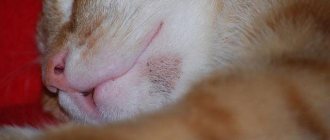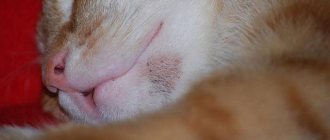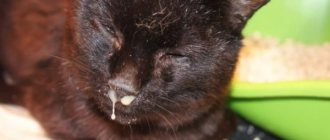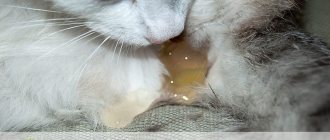Save the article:
In cats, like in humans, acne can appear on the skin - this is a dermatological disease that is not contagious to humans and is associated with improper functioning of the sebaceous glands. Acne in cats is quite rare, so acne noticed by the owner on the pet’s chin, belly, near the mouth, ears and base of the tail can cause quite a surprise. It is in these areas of the skin that the sebaceous glands are most numerous - a disruption of the metabolic process in the skin makes their functioning abnormal.
The pores of a cat's skin become clogged due to the accumulation of old epithelium stuck to the young skin cells by sebaceous secretions. Cat pimples can be white or black depending on whether the sebaceous plug is inside or outside the pore.
Since the process does not always develop into pathology, the phenomenon of self-healing takes place. But when pathogenic microbes get into the pores, the pet’s health faces problems: even the behavior of the animal shows how uncomfortable it is. The sore spot itches and hurts, the cat doesn’t feel well, so treatment begins immediately.
Causes of acne in cats
Since acne can affect any pet, it is worth carefully studying the list of causes that provoke the disease:
- constant stress causes active work of the sebaceous glands;
- if a cat gets his chin dirty, you should understand that he will not wash it himself, and the dirt with microorganisms will remain on the skin;
- skin diseases;
- malfunction of the sebaceous glands;
- poor development of hair follicles (alopecia);
- weak immunity;
- plastic dishes, especially those that are not the first freshness, are a breeding ground for bacteria that have accumulated in their micropores.
Rashes on the skin can appear in both a kitten and an elderly cat, and despite this, sphinxes suffer from acne more often, and neutered cats and sterilized female cats suffer from acne in isolated cases.
Standard diagnostics
Although acne on a cat’s chin may seem like a minor disease that does not require consultation with a veterinarian, this impression is wrong.
You need to seek help at least in order to make a differential diagnosis, which will help determine whether this is really a simple malfunction of the sebaceous glands or something more dangerous.
The appearance of red pimples on the face can be a symptom of many other diseases: demodicosis, allergies, scabies, eosinophilic granuloma, etc. Some of these conditions pose a threat to humans, so contacting a veterinarian is necessary.
When visiting a veterinary clinic, specialists must take a skin scraping and use it to make an accurate diagnosis. Depending on the test results, appropriate treatment is prescribed.
Reviews from veterinarians about acne
global $ads_google;
//data-ad-slot=”2475549904″ $ads_google = empty($ads_google) ? false : true; ?> if ($ads_google == false) {?> $ads_google = true; ?> } ?> The opinion of representatives of veterinary dermatology is expressed in the advice not to self-medicate, but to visit a specialist: the sick animal must be examined, a scraping taken from the affected area of the skin and a laboratory test performed. This is done in order to exclude the possibility of other diseases, including allergies.
Feline acne is similar in symptoms to dermatophytosis, demodicosis, scabies and eosinophilic granuloma. The analysis will show whether there is reason to worry about the above diseases.
Veterinarians do not consider the disease to be serious and prescribe a qualified treatment regimen, which, if followed, will solve the problem quickly and easily.
In conclusion
Acne in a cat can occur regardless of age, gender, weight, breed, etc. Skin disease in animals, according to reviews from breeders and doctors, is one of the most common. It should also be noted that in some cats, acne and blackheads on the chin go away on their own, only occasionally appearing in small quantities. In this case, even the owners do not always detect the problem, which can be resolved without outside intervention.
It is not difficult to cure this skin disease in a cat. The main thing is not to self-medicate, observe hygiene requirements and provide the animal with balanced nutrition.
Treatment of acne in cats
Acne can also appear on the tail, which also brings problems and inconvenience to the pet. At home, it is recommended to follow a diet and follow the instructions of veterinarians, who always tell in detail how to treat acne .
First of all, you should take care of the hygiene of the living conditions of the animal and the mustachioed sufferer himself. In cats, black spots on the chin can turn into large abscesses and seriously complicate life. Maintaining hygiene will not allow the disease to progress to the next stage due to the penetration of microorganisms into the pores.
Treatment is prescribed according to the following scheme:
- the affected areas are regularly washed with medicated shampoos;
- before applying medications, the skin is first disinfected with hydrogen peroxide 3%;
- if the pet is fluffy, then it is better to shave the hair on the affected area;
- Be sure to exclude fatty foods from the diet.
If the case is complex, and a secondary source of infection has joined, then a topical antibiotic and a course of vitamin A are included in the regimen.
Folk remedies for treating acne in cats
Not everyone wants to use ready-made products and turn to folk recipes for treating acne in cats .
- Calendula tincture is used as a treatment;
- two tablets of furatsilin are ground into powder and mixed with three tablespoons of chamomile decoction. The resulting solution is stored in the refrigerator and used to treat ulcers 5-6 times a day;
- squeeze the juice out of the pumpkin and wipe the affected area 4 times a day for 5 minutes;
- An effective decoction is obtained from celandine, which is prepared from four tablespoons of dry raw materials and a liter of water. The broth is brought to a boil, removed, cooled and filtered. Apply lotions to the wounds 3 times a day.
However, before you start treating kitty with folk remedies, consult a veterinarian.
Key points of the treatment plan
It is not difficult to get rid of acne in cats at home. By following simple rules of hygiene, maintaining the most sterile conditions of the diseased area of skin on the chin, the likelihood of the spread and penetration of pathogenic microorganisms deep into the epidermis of the animal will thus be reduced to zero.
Treatment of a problem such as cat acne is based on the general treatment regimen for skin diseases presented below:
- Regular shampooing of the affected area.
- Before starting treatment procedures, a disinfectant wipe with 3% hydrogen peroxide is required.
- For long-haired pets, it is better to shave the hair in this area.
- The application of external preparations should be preceded by the dissolution of the stratum corneum of the skin.
- Treatment with antibiotics is usually necessary in complex cases when the area of the rash is rapidly increasing.
Self-medication is not the best solution
Among cosmetic products, as many owners note, lotions and scrubs help relieve itching. Compared to medications, which only a specialist should prescribe, the owner can purchase these on his own or select them from his own supplies. However, even with such seemingly safe remedies, you should be careful: adding allergic acne to the initial acne in cats can simply aggravate the course of the disease.
In any case, treatment of the disease should be under the full supervision of a veterinarian. Having a sufficient level of qualifications, a professional will objectively compare laboratory data with the information received during the examination.
The intensity of therapy for pet acne is determined by the frequency of rashes, the duration of the disease and its degree of neglect. For mild forms of manifestations, local treatment is usually prescribed, and for more extensive skin lesions, complex treatment is prescribed. At the same time, the main thing:
- Do not squeeze out blackheads and blackheads.
- Adjust your pet's diet, eliminating possible allergic irritants.
- Treat until complete recovery, since early relief does not guarantee final success.
Cat acne on the chin
Black dots may suddenly appear on the cat's face in the lip area. The muzzle seems dry. Gradually the rashes turn into pustules. They will soon burst, and in their place a scab will become noticeable. The next symptom is hair loss with the formation of dry, inflamed skin in this area.
The cat often scratches its chin, thereby causing a secondary infection and injuring the sore spot.
Pus may begin to leak from the pimples, which means that the process has gone far, and the suffering cat urgently needs help.
Someone is lucky, and his pet never encounters the problem of acne breakouts in his life, but visits some kind of pussy with enviable regularity. You should always carefully examine the animal's face so that if a rash appears, treatment can begin immediately.
Treatment of acne in cats on the chin
global $ads_google;
//data-ad-slot=”2475549904″ $ads_google = empty($ads_google) ? false : true; ?> if ($ads_google == false) {?> $ads_google = true; ?> } ?> Judging by the reviews of cat owners who have suffered from this dermatological disease, complex treatment will very soon give a good result.
How veterinarians advise treating acne:
- the chin is treated several times a day: the shaved area is washed with tar soap, antiseborrheic shampoo or Lactaderm. The shampoo is left on the cat’s skin for 4-5 minutes, washed off with a damp cotton swab and wiped until dry;
- Chlorhexidine or hydrogen peroxide are used as antiseptics. After 15 minutes, proceed to the next stage of treatment;
- the cat is laid on its back and a soft cotton piece of cloth soaked in moderately hot decoction of calendula is applied to the sore spot;
- the lesion is wiped with salicylic acid and acne ointment for animals is applied.
A diet with a vitamin course and all stages of treatment are carried out until all spots and ulcers completely disappear.
Feline miliary dermatitis
Miliary dermatitis is called eczema and even cat mangy. This is a common cat disease. Veterinary dermatologists prefer to call this condition a special skin reaction. Indeed, these are symptoms of many diseases. Cat skin has a limited number of options for responding to different disease conditions. A small rash that feels like sandpaper and is accompanied by itching is not a disease, but a symptom of a disease.
Miliary dermatitis is a scattering of small pimples, or nodules, on the skin, localized or covering the entire body. Typically, these pimples crust over and turn into scabs that can be easily felt through the cat's fur when you pet your cat. The term “miliary” means “millet-like” - the nodules feel like grains of millet to the touch.
Countless reasons. Typically, this skin condition is a sign of hypersensitivity, an allergic reaction of the animal to a variety of things. The most common causes are flea allergies, respiratory allergies, or food allergies. Increased sensitivity to skin parasites can cause the same symptoms.
Infectious diseases such as ringworm can also cause miliary dermatitis. Even bacteria, immune disorders, reactions to medications and digestive problems can manifest as crusts on the skin. One in six cases of miliary dermatitis is idiopathic , meaning that the cause cannot be determined. To cure this skin condition, you need to identify its cause and eliminate it.
Establishing diagnosis. The location of the rash on the body can often provide an indication of its cause. If the rash is on the head and neck, then most likely it is a food allergy. If the base of the tail is affected, it is most often a reaction to fleas. If a rash is noted throughout the body, doctors suspect respiratory allergies or atopy. Flea allergies and atopy are seasonal phenomena, while cats suffer from food allergies all year round.
Treatment for miliary dermatitis begins with a series of tests aimed at identifying the cause of the condition. Fleas are probably the most common culprit. Since even one flea bite causes an allergic reaction, and cats themselves lick themselves zealously, it can be difficult to detect traces of fleas in a cat’s fur coat. You can suggest this way of checking for fleas: you scratch-scratch-scratch the cat's coat and put all the combed dirt on a wet white cloth. If it is flea excrement, then the black specks turn red.
Respiratory allergies are often caused by pollen, mold and indoor dust , and diagnosis requires intradermal testing. Suspected allergens are placed inside the skin (not under the skin) by scratching a shaved area of the cat's skin, which has previously been given a sedative. In the case of a positive reaction, the scratch swells and becomes redder after 5-15 minutes; in a negative reaction, there is no inflammation.
If miliary dermatitis is a food allergy, the rash will persist as long as the cat is exposed to that type of food. To diagnose a food allergy, a cat is put on a diet that includes ingredients it has never eaten before. If symptoms disappear, then some component of the old diet is to blame for the disease. These old components are added one by one to the new diet and monitored which one will cause an allergic reaction. This diagnostic feeding can last up to 12 weeks and should be done under medical supervision.
Miliary dermatitis in the armpit
Almost every cat with miliary dermatitis has several different skin scrapings taken to determine whether there are skin parasites. Three species of Cheyletiella mites cause skin lesions, also called dandruff, because the white, moving parasites are often mistaken for skin flakes. These mites live in the horny substance (keratin) of the outer layer of skin. Cats become infected with them either through direct contact with infected cats, or through indirect contact with other parasites that carry this mite, such as fleas, lice and flies.
Otodectes cynotis, also known as the ear mite, can also cause miliary dermatitis on the head and neck. About three percent of cases of miliary dermatitis are caused by ear scabies.
Rarely found in cats, demodicosis is known as glandular mange and is caused by the mite Demodex cati, which lives in the hair follicle (hair follicle). It can also cause miliary dermatitis.
Cats suffering from pediculosis , that is, infected with the lice-eater Felicola subrostratus, or chewing louse, may also show signs of miliary dermatitis .
Ringworm in cats can be caused by Microsporum gypseum, Trichophyton mentagrophytes or Microsporum canis, with the latter being the causative agent in most cases. But any of the above parasites can cause signs of miliary dermatitis along with ringworm symptoms such as bald spots and redness of the skin. Therefore, when diagnosing stubborn miliary dermatitis, it is recommended to do a ringworm test. The wool from the affected area is placed in a special nutrient medium (Sabouraud, Chapek agars) and incubated for at least 15 days.
Treating itching is not treating the disease. If you use standard allergy treatment, the symptoms of miliary dermatitis may be relieved, but they will return if this treatment is stopped. It is necessary to constantly monitor the presence of fleas in a cat if she is allergic to fleas. There are a huge number of products available on the market for the safe removal of fleas both from a cat and from its surrounding home environment.
The best therapy for respiratory allergies, according to experts, is frequent bathing of the cat: in this case, you wash off the allergen from its fur. A mild shampoo that does not dry out the skin or simply rinsing the cat with clean water is suitable for this. Some cats susceptible to atopy benefit from immunotherapy. Once the causative agent of the allergy is identified, the cat is given a series of injections of a drug based on this allergen in order to increase the resistance of the animal’s own immune system. Results appear slowly, and treatment usually lasts a year or more. Maintenance, preventive injections can be repeated periodically to make the cat feel more comfortable.
Miliary dermatitis caused by food allergies goes away as soon as you can find a suitable diet.
With the exception of the Demodex mite, the skin parasites that cause miliary dermatitis are highly contagious, and if such an infection is detected, all animals in the household should be treated. Treatment consists of weekly treatment of animals with appropriate drugs for three to four weeks. After this first period of treatment, tests are done to check for parasites. If the test results are positive (that is, confirming the presence of the parasite), treatment continues with weekly screening tests until a negative result is obtained. After this, treatment continues for another week to consolidate the effect.
Many hidden causes of dermatitis can be treated well with cortisone. Steroids and antibiotics are prescribed to relieve severe itching or kill infection.
But the diagnosis of the root cause of dermatitis is very important; there is no point in treating itching by itself. The painful condition may worsen if ringworm is treated with cortisone. Modern therapy for ringworm should include the use of a new vaccine against Microsporum canis in combination with medical baths, local ointments and environmental disinfection.
Source: Galina Starostina
Treatments for cat acne
The list of medicinal drugs includes Chlorhexidine, Miramistin, hydrogen peroxide, salicylic alcohol and iodine. These are antiseptic and disinfectants. There are also narrowly targeted drugs:
- Percutan - the medicine contains furatsilin, and if it is used twice a day according to the instructions, the coat color will turn yellow, but this is temporary;
- Bactroban - an ointment for external use is used at the stage of purulent and bloody crusts, as well as when a secondary infection occurs;
- Mupirocin is an effective ointment for external use;
- Differin, Adaklin, Clenzit are vitamin A in the form of ointments, but you should not apply them diligently due to possible skin irritation;
- Prednisolone - a course of treatment is prescribed only by a doctor in particularly advanced cases.
Do not forget that all medications are used only with the permission of a doctor.
Causes and provoking factors
The cause of the problem may be the individual characteristics of the body. At the same time, the owner needs to properly care for the pet, which will reduce the number of black spots. An additional factor in the occurrence of acne in the chin area is that this area has the least amount of hair. This makes it easier for bacteria to get into the pores.
Additional factors:
- poor nutrition;
- hormonal disorders;
- decreased immunity;
- liver diseases;
- pathologies of the sebaceous glands.
When the sebaceous gland is blocked, the excretory duct may become inflamed, which causes pain.
The problem can also occur on the hips, elbows and eyelids. Inflamed sebaceous glands can cause discomfort to the animal, causing pain. The skin in the acne area becomes red and sometimes swells slightly. Chronic intoxication, which occurs as a result of infection of the body with parasites, can provoke the appearance of black spots. At the same time, the waste products of helminths contribute to disruption of the functioning of various systems.
Attention! If a cat has acne, it is necessary to check the condition of the paraanal glands, which are located next to the anus. If they are inflamed, you should definitely consult a doctor. Otherwise, acne will appear again and again.
Why acne occurs in animals - video
Preventing acne in cats
For prevention purposes, plastic utensils are replaced with glass, ceramic or iron. The bowl is washed 1-2 times a day, and new food is poured only into an empty, clean plate. Water should always be clean and fresh.
If your cat has acne again , then fatty and dry foods are excluded from the food, as this is a risk of relapse of the disease.
For a cat prone to comedones, wipe his face after eating.
Your pet’s immunity needs to be strengthened, so if you have questions, you need to study the recommendations for proper nutrition for your cat.
Illustrations
Acne on the Neck
Atopic miliary dermatitis
Demodectic mange in cats
Malassezia Dermatitis
Pemphigus
How to remove hematomas?
After establishing the nature and characteristics of the hematoma, treatment is prescribed in accordance with the information received:
- prescribe UHF procedures;
- a surgical opening is performed to remove accumulated clots and rinse the cavity;
- the patient is hospitalized in the surgical department for opening and drainage, followed by antibiotic therapy.
Recovery time depends on the extent of the lesion, the presence or absence of infection and other factors.
What can be done
You may genuinely not understand why your cat is constantly licking and scratching. Visit a veterinarian and he will recommend a drug that alleviates the animal’s condition or select a suitable dietary food. You may even need to use certain medications to treat skin reactions. It is important to monitor your cat during treatment to ensure that its condition improves and not the other way around. If the problem is not resolved, you may be dealing with another skin condition. During the examination, the veterinarian will provide the pet with the necessary assistance. Make a list of all the symptoms you notice in your cat to make it easier for your doctor to diagnose the disease.
You love your cat and will not watch her suffer. Although your pet takes great care of her appearance, check her skin and coat regularly to detect any problems. Pay attention to changes in skin odor, itching, and changes in your washing routine. The sooner you notice the problem, the better for your cat.
Contributor Bio
Erin Ollila
Erin Ollila believes in the power of words, that her message can bring a lot to people and even change them. Her writing can be found all over the internet and in print, and includes interviews, articles, blog posts and creative non-fiction. Erin is a fan of SEO and all things social media. She graduated from Fairfield University with a Master of Arts in Creative Writing. You can find her on Twitter @ReinventingErin or learn more about her at https://erinollila.com.










